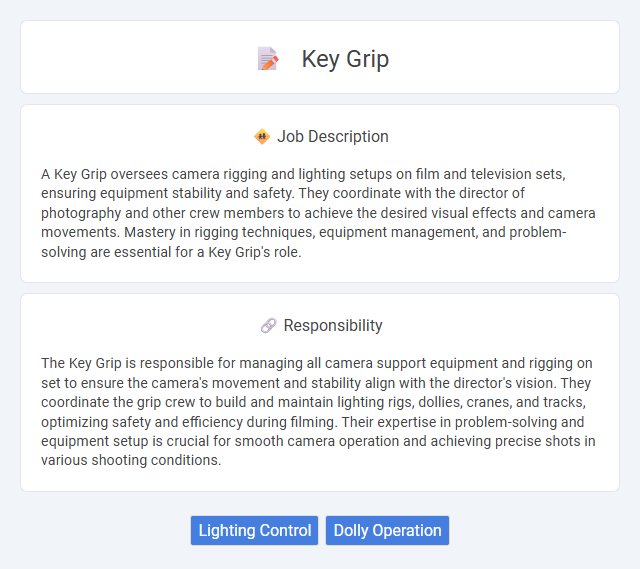
A Key Grip oversees camera rigging and lighting setups on film and television sets, ensuring equipment stability and safety. They coordinate with the director of photography and other crew members to achieve the desired visual effects and camera movements. Mastery in rigging techniques, equipment management, and problem-solving are essential for a Key Grip's role.
The Key Grip role likely suits individuals with strong physical stamina and problem-solving skills, as the job demands managing and securing heavy equipment safely on set. People who are comfortable working outdoors in various weather conditions and can collaborate effectively with camera and lighting departments probably find this role fitting. Those prone to physical strain or who prefer less physically demanding environments may not be well-suited for the responsibilities of a Key Grip.
Qualification
Key Grips require comprehensive knowledge of camera equipment, rigging, and lighting setups to ensure smooth production workflows on set. Essential qualifications include hands-on experience with grip gear, a strong understanding of safety protocols, and the ability to collaborate closely with the director of photography and lighting teams. Certification in rigging or specialized training in film production technology significantly enhances a candidate's expertise and employability in this role.
Responsibility
The Key Grip is responsible for managing all camera support equipment and rigging on set to ensure the camera's movement and stability align with the director's vision. They coordinate the grip crew to build and maintain lighting rigs, dollies, cranes, and tracks, optimizing safety and efficiency during filming. Their expertise in problem-solving and equipment setup is crucial for smooth camera operation and achieving precise shots in various shooting conditions.
Benefit
The Key Grip role likely offers significant benefits, including competitive compensation and opportunities for career advancement within the film and television industry. This position may provide valuable hands-on experience with lighting and rigging equipment, enhancing technical skills and industry knowledge. Health benefits, union membership perks, and networking opportunities could also be common advantages associated with this job.
Challenge
The key grip job likely involves overcoming significant physical and logistical challenges on set, requiring quick problem-solving skills and adaptability. Managing complex rigging setups and ensuring safety while working under tight schedules probably demands a high level of expertise and situational awareness. Handling sudden changes in shooting conditions might often test a key grip's ability to maintain smooth production flow.
Career Advancement
A Key Grip coordinates on-set rigging and camera support, ensuring smooth production operations. Mastery of equipment handling and leadership skills opens opportunities for promotion to roles such as Gaffer or Production Manager. Continuous professional development and networking within the film industry enhance prospects for career advancement.
Key Terms
Lighting Control
A Key Grip is responsible for managing lighting control on film sets by rigging and adjusting equipment such as flags, diffusers, and reflectors to shape and modify natural and artificial light. They collaborate closely with the Director of Photography and Gaffer to ensure precise light positioning and intensity, optimizing the visual quality of each shot. Expertise in operating grips' tools and understanding lighting mechanics is essential for maintaining safety and achieving desired lighting effects.
Dolly Operation
The Key Grip oversees all camera rigging and ensures secure equipment setup while specializing in dolly operation to achieve smooth and precise camera movements on set. Mastery of dolly track placement and coordination with the camera crew is essential to capture dynamic shots and maintain visual continuity. Expertise in adjusting dolly speed and positioning enhances shot composition and supports the director's creative vision during filming.
 kuljobs.com
kuljobs.com